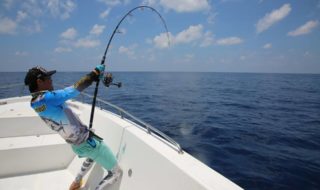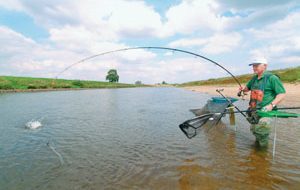When the Division One National record was smashed in 2004 with more than 160lb of barbel and bream, it was all the encouragement Total-Fishing.com needed to check out the stretch of the River Trent that produced it.
| The Trent at Collingham is pretty featureless but full of barbel. Here Malc tires out a scrapping five-pounder. |
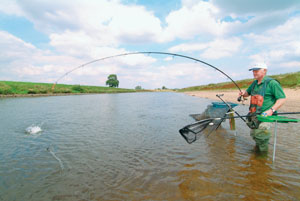 |
THE mighty River Trent was once the match angler’s Mecca. However, these days it’s increasingly the place to go if you want to bag up with barbel.
Specimen hunters love the place, but so do plenty of ‘in the know’ pleasure anglers and matchmen, all of whom have barbel on the brain!
We joined Collingham AC members Joe Cox and Malcolm Nicholson on their home water for a spectacular barbel-bagging session.
“The Trent below Collingham weir is tidal and although the rise and fall of water twice per day is fairly slight, it still has a noticeable effect,” explained Joe. We were viewing the fairly featureless stretch below the bubbling white water of the weir pool that recently set a new all-time NFA National record
“How it affects the feeding of the fish in the river is difficult to assess, and perhaps the most important aspect to successful barbel catching is to actually just locate the fish and then persist in trying to encourage them to feed. Here, just below the weir, there are always loads of fish,” added Joe
The peg immediately below the weir is where Steve Clark won the Division One National with 72.920kg in the middle of July. That’s more than 160lb and the word is that he had to move on barbel anglers who were fishing his peg when he arrived, and they had been bagging up as well. You can gather from that that there are a few barbel in the area!
Just then, Joe had to take a break from his Trent barbel lesson as his feeder rod arched over under the unmistakable strain of a barbel bite, and he leaned into his fifth hard-fighting fish of the day.
“The Trent is a changed river,” he grinned, once the bronze beauty was nestling in the folds of his landing net.
“Once upon a time it was artificially warmed by the power stations all along it. Back then, it was a dirtier river and that suited the skimmers and roach, which were able to feed confidently without fear of being eaten by a predator.
“These days it’s cleaner but also clearer. There are still loads of fish in the river, but perhaps not the kind that make for an even day’s match fishing, and that’s as much a reason as any why match angling has dwindled on the river.”
Cormorant predation has taken its toll too, of course, and the lure of commercial carp waters has certainly had a major impact on angler numbers on this river, and others too.
However, one species in particular has thrived on this certain amount of neglect and that is the barbel. In truth, it’s fair to suggest that the state of the river now suits them perfectly.
“It’s all about big fish now really,” added Joe. “As well as the barbel there are loads of really big bream and plenty of carp. I never thought I’d see the day when the Trent was regarded as a big-fish river by so many anglers.”
Barbel tactics
There are many styles and methods for catching barbel and they each have their advantages and disad-vantages, and some will work when others won’t, depending on conditions.
“Today, I am keeping things simple with the main aim of accumulating a large catch of barbel, no matter what the size,” explained Joe.
“If I was determined to catch some real specimens, then perhaps a boilie or pellet-based approach would be more successful. However, I am happy to catch smaller fish from 2lb to 8lb, which give brilliant sport.”
Joe and Malcolm had opted to fish the lower end of their club stretch, which is a well-known barbel-holding area.
“For whatever reason, these pegs hold loads of barbel in the warmer months,” explained
| The best fish of the day at just under 7lb fell for Joe. If you want to target big fish, use boilies or pellets on the hook. |
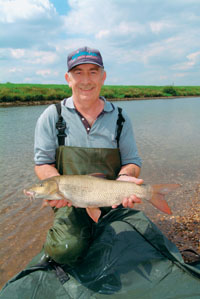 |
Malcolm, who had also had several fish already.
“I think it is just the abundant food availability that keeps them here. You only have to look at all the empty snail shells on the tide line to see that there must be a lot of food out there on this gravel-bottomed area of the river.”
The river at Collingham is around 50 metres wide and up to nine feet deep in parts. Joe and Malcolm base their approaches around four principle baits – casters, hempseed, corn and red maggots.
“Hempseed is a great, cheap bait for feeding and holding barbel and they never seem to tire of it,” said Joe.
Casters can be fed and also used on the hook. The other two main hook baits are corn and maggots. They do not feed maggots, as they tend to attract too many small fish.
“The single, most-important thing about barbel fishing, in my experience, is to feed the swim you have chosen persistently,” said Joe. “That means having plenty of bait with you and being prepared to introduce it via a swimfeeder on a frequent basis.
“For example, I will cast out once per minute for the first half an hour in order to lay down a large carpet of feed particles in the swim. Barbel can switch onto feeding at any time and my advice is to just keep on feeding the swim and, eventually, they will respond.”
Balanced power
Typically, Joe and Malcolm say you need to be armed with at least five pints of hemp, three pints of casters, a pint of red maggots and a couple of tins of corn, for a session on this part of the river. The tackle needs to be powerful, and balanced.
“A rod with a length of 11ft to 12ft is ideal and a test curve of around 1lb to 11/2lb is enough to handle these barbel,” said Joe. “My personal preference is for a Drennan IM8 12ft Super Feeder rod and I use nothing less than 8lb Maxima main line.
“Simply, I will state that if you try and get away with less, then you will certainly come unstuck. These fish are exceptionally powerful creatures and can break you on the bite as they make off with the bait if you are not correctly geared up.”
| Both use Shimano Baitrunners. |
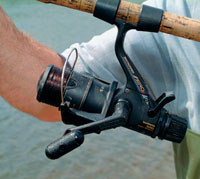 |
The reel is a Shimano Aero 5010 Baitrunner and Joe urges all anglers to use a free spool reel of some description. Bites are often ferocious takes from barbel and you can be smashed on the take, but by using a free spool reel you will prevent this from happening.
“A 6lb hooklength is the minimum I would use,” he added. “The actual length of the tail can be varied, but I tend to start with a fairly long one, at around three feet. I believe that the barbel will take a small bait drifting naturally in the current alongside the loose feed spilling out from the feeder.
“Barbel do not feed exclusively on the bottom, despite them having an underslung mouth. They rise well off the bottom to intercept food items and by using a long tail I can make the hook bait mimic all the loose feed that is trundling through the swim. This is especially useful in the warmer weather. It is easy to vary the length of the tail anyway, and if bites are not being hit, I would have no hesitation in short-ening it. Sometimes even a very short 2in to 3in inch tail can score. The point is, be experimental if bites don’t come. Some days the fish will want the bait nailed on the deck.”
Small hooks
The fishing is not all about being aggressive, however, and despite the fish running to 8lb plus, both anglers believe that you need to use small hooks to maximise your catches.
“We like to use a size 16,” said Joe. “These need to be strong hooks of course, like a Kamasan Animal pattern, and I would advise using some superglue on the knot for extra security.
“Whenever you feel that the line has become rough near the hook, due to abrasion, change the hooklength immediately, or you will risk losing the next fish for sure,” added Malcolm. He was into a fish that was fighting strongly, charging all over the river and making his reel scream backwards at times. Brilliant fun!
Typical hook baits for this type of fishing are a single grain of corn, three casters, double caster or a bunch of maggots.
“I will always vary the hook bait until I find a response,” said Joe. “Some days barbel can be fussy, other times they don’t care what’s on offer. I do not find it necessary to hair rig the bait but I would not discount its usefulness of course. I think that in this pace of water there is no real need to hair rig because the fish don’t have much time to inspect a passing bait. By all means try it if bites are hard to come by though.”
Tangleproof
The margins on the river at this point are shallow and the lads had set up a few metres out into the flow. Everything was secured tightly as it is easy to lose tackle in the flow, especially the landing net. Standing to fish allows the rod to be placed high on a rod rest.
“It’s important to keep the line out of the flow in this way,” explained Joe. “The flow is strong and too much pressure on the tip from the water would prevent bites from being seen as
| Be prepared to use long hooklengths and small, strong hooks to get bites in the day. |
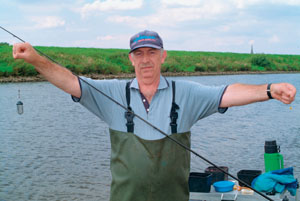 |
easily.”
The rigs the anglers were using were really simple and virtually tangleproof. A blockend feeder, such as a black cap Kamasan model, is perfect for the job.
“Your feeder needs a loading of 50gr at least and, if it’s flowing very hard, that can be upped by adding clip-on leads up to a total weight of 80gr plus at times,” advised Joe.
“The key point is that the feeder needs to hold bottom where it is cast, otherwise you are spreading the feed too widely and not concentrating the fish into a hotspot.”
A loop is made in the main line and the feeder sits on that. A smaller loop is formed off the end of the main loop and the hooklength is attached to that via a loop-to-loop system or a swivel. It could not be simpler.
Reading the river
Choosing where exactly to cast to in the river is obviously an important consideration.
“I would always advise making a few exploratory casts with an empty feeder first of all,” added Joe.
“I’d be looking to establish if there are any potential snags and trying to ascertain the depth, looking primarily for a drop-off or gully, as these are where the fish tend to lie, just out of the main current.
“Here, I am making a cast to about mid-river and that’s where the fish are to be found in abundance on these pegs. But other areas of the river may be different and you need to pick a length and get to know it extensively in order to really reap the rewards.”
Bites were coming steadily as the warm and settled conditions had clearly sparked the barbel into feeding well. The rod set up high on the rest just rattled a couple of times, then usually arched over as a boisterous barbel took the bait with some great measure of force and speed. They were quite breathtaking bites, amplified by the strong current of course.
Bites are strong and the free spool reel comes into its own at that moment. If you are not watching the rod tip and a bite occurs, then the reel will allow line off the spool as the fish charges off. All you really have to do is lift up the rod and the fish should be on, with no real need to make a heavy striking action.
Playing your quarry
Playing a barbel of any size is a lively experience. You need to try and bully them as much as you can but, with a small hook and with their overall power in the flow, you can’t give them too much stick or you may risk having the small hook pull out.
Take your time, but always keep in command. The 8lb line should be plenty enough to tame most barbel fairly swiftly.
“To be honest, the most critical stage is when the fish is within sight of the landing net,” said Malcolm, as another 5lb fish darted about just beyond netting range.
“They can roll over the line or crash off in a new direction and you need to be aware of this potential. The skill is to tire them out and slide them easily into the landing net, which is easier said than done sometimes. Don’t snatch at them because you can easily lose the hook hold using a size 16. Just be patient and let them run if they need to. Soon enough they will be in the net.”
| Not a bad haul by anyone’s standards and the good news is it’s pretty trypical if you do it right. |
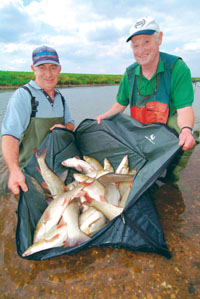 |
Once landed, be sure to have a strong disgorger or a pair of forceps ready to extract the hook carefully and swiftly. Try not to touch the fish and if you put them in a keepnet, make sure it’s a big one and don’t keep them for too long.
A keepnet can be useful in order to allow a barbel to recover itself, but really we used one for this feature so that you could see the catch potential of the stretch. Our advice is to let them go straightaway if you can.
As for returning individual fish, always hold the barbel in the water facing upstream and never let one go if it turns belly up. The build-up of lactic acid can cause them to be exhausted after a strong fight and you should be mindful to allow them plenty of recovery time.
Hold them upright by the tail and facing the flow and wait for them to kick their tails and swim away. Between them, Joe and Malcolm netted over 20 barbel from 3lb to 7lb for our session.
They displayed them for a picture in a soft zip-up unhooking mat over the water, and all the fish went back very swiftly and very energetically.
“The Trent is a barbel angler’s paradise now,” concluded a delighted Joe. “Any angler who has not caught one of these jet-propelled creatures doesn’t know what they are missing and they should give them a go as soon as possible.”
Malcolm and Joe went on to catch, and immediately return, another 35 barbel to 8lb after we left. Phew! Solid or what?
Top Tip
The presence of shells on the shoreline of tidal sections of river show that this is an area holding lots of natural food and is therefore likely to be an excellent fish-holding area.
In Pursuit Of Trent Barbel
1 The feeder, a Kamasan Black Cap from 50gr upwards, is fished on an 8in loop.
2 The feeder is three-quarters filled with hempseed, which creates a bed of feed on the deck.
3 Add perhaps 20 casters – the flow will pull these from the blockend feeder.
4 In high-flow conditions you will need to add up to 30gr of strap leads.
5 Don’t forget to keep your hemp in water to prevent it drying out and floating.
6 Joe starts with a long hooklength but has fished hooklengths as short as two inches.
Barbel Tackle
Joe and Malcolm like to use an 11ft to 12ft feeder rod with a test curve from 1lb to 11/2lb. This is the Drennan IM8.
Fishing with the rod pointing skywards means most of the line is kept out of the flow and it’s easier for the feeder to hold bottom.
Although they are fishing for big fish, they have found small, strong hooks like the Kamasan Animal in size 16 brings them more bites.
Barbel Bait
1 A triple-caster bait hooked in this way is effective. Joe always superglues the hook knot.
2 Four maggots sit nicely on a size 16 hook. Any more and it pays to hook them ‘upside down’.
3 You can be sure the sweetcorn sits motionless on the bottom, even in very swift flows.
4 Casters can be fed through the feeder, but remember to remove any floaters and to keep the rest in water.
5 Do not feed any maggots through the feeder. They attract too many small fish.
Top Tip
If you have one, always use a free spool reel for barbel fishing. Bites are ferocious and without a free spool facility on the reel it’s all too easy to be smashed on the take. Never use less than 8lb main line and 6lb hooklength.
Venue Fact File
River Trent, Collingham, Notts
Controlling club: Collingham AA controls a 300-peg stretch from Peg 1a at Collingham Weir to Peg 300 at Beesthorpe
Tickets: £5 day ticket on the bank and £5 for a night ticket. You need to apply to join the club and there is a waiting list. The cost is £60 for seniors
Contact: 01636 892700 or 01636 893364
How to get there: Collingham village lies off the A1133 just northeast of Newark. Off Low Street, take Ferry Lane and at the church follow the signpost to the river. You can drive onto the flood bank



